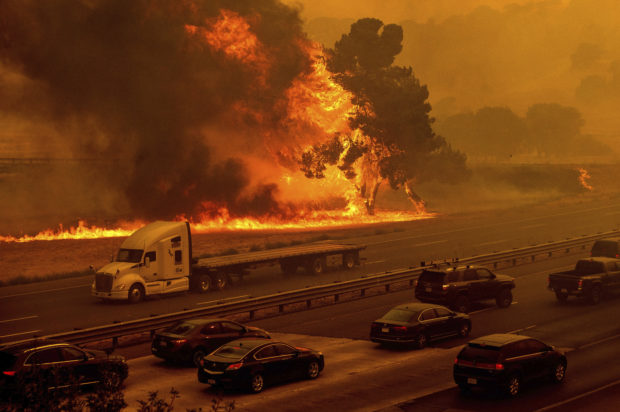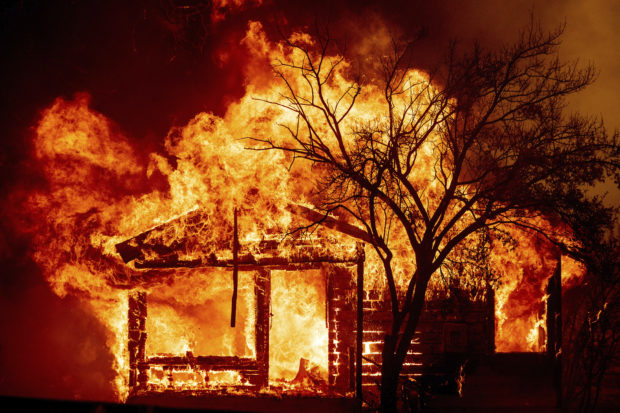Lightning blitz keeps wildfires raging across California

Flames from the LNU Lightning Complex fires jump Interstate 80 in Vacaville, California, Wednesday, Aug. 19, 2020. The highway was closed in both directions shortly afterward. Fire crews across the region scrambled to contain dozens of wildfires sparked by lightning strikes as a statewide heat wave continues. (AP Photo/Noah Berger)
SANTA CRUZ, California — More than two dozen major fires were scorching California on Thursday, largely the result of an unprecedented lightning siege that dropped nearly 11,000 strikes over several days.
“This is definitely a historic lightning event,” said Daniel Berlant, an assistant deputy director with the state Department of Forestry and Fire Protection. “The last time we had a lightning siege that was even comparable was in 2008.”
The fires have destroyed 175 structures, including homes, and are threatening 50,000 more, he said; 33 civilians and firefighters have been injured. Most of the activity is in Northern California, where fires have chewed through nearly 500 square miles (1,250 square kilometers) of brushland, rural areas, canyon country, and dense forest surrounding San Francisco.
Fires also burned in the Sierra Nevada and Southern California wildlands. With so many burning at once, firefighters say they’re unable to tap resources such as extra personnel and equipment. In Marin County, just north of San Francisco where a small fire is burning near the Pacific Ocean, county fire chief Jason Weber said they are waiting for assistance from Montana to arrive this weekend.
He said that in his 25 years in fire service, “we’ve never seen this level of draw-down” with heavy competition within the state and in the western U.S. for equipment and people.
Berlant said the state has requested 375 engines from out of state, with some already in the state and others scheduled to arrive soon.
About 26,000 people in Santa Cruz County were under orders to evacuate, sheriff’s department chief deputy Chris Clark said Thursday. Another 1,000 people in neighboring San Mateo County were also under evacuation orders as the so-called CZU August Lightning complex fire grew overnight to 62 square miles (160 square kilometers).
Officials said the fire had the potential to grow significantly in the next 24 hours and one of the tools they have— given stretched resources— was for people to leave their homes when told. But some people refused when officers went door-to-door Wednesday night, said Cal Fire Chief Mark Brunton.
“With the resources that we are lacking, we ask you to help us to help us to do our jobs and to keep the public safe,” he said.
Kevin Stover, 42, was struggling with indecision early Thursday morning when a mandatory evacuation order was issued for the rugged and small town of Felton outside the beach city of Santa Cruz.
“I don’t want to leave,” said Stover, a camera operator and rigger now driving for Door Dash and Lyft because of the pandemic. His car, loaded with important papers, his father’s urn, and some arrowheads that meant a lot to him, had a flat tire. He had put a plug in the tire and patched it with gaff tape.
“I’m trying to figure out if I should cut these original oil paintings out of the frame to salvage them,” he said.
In addition to about two dozen major blazes, small fires kept erupting, though most were quickly stopped.

Flames from the LNU Lightning Complex fires consume a home in Vacaville, Calif., Wednesday, Aug. 19, 2020. Fire crews across the region scrambled to contain dozens of wildfires sparked by lightning strikes as a statewide heatwave continues. (AP Photo/Noah Berger)
In central California, a pilot on a water-dropping mission in western Fresno County died Wednesday morning when his helicopter crashed. The pilot was working with Fillmore-based Guardian Helicopters, which had a contract with the state fire agency to provide emergency services, said Zoe Keliher, an investigator with the National Transportation Safety Board.
A Pacific Gas & Electric utility worker died at a fire in the Vacaville area between San Francisco and Sacramento but circumstances were not clear. The worker was found in a vehicle and CPR was performed but he was pronounced dead at a hospital, said a California Department of Forestry and Fire Protection statement.
He had been clearing poles and lines to make the area safe for firefighters, Cal Fire said.
The state recorded nearly 11,000 strikes in 72 hours, Gov. Gavin Newsom said Wednesday.
Two fires in Sonoma County prompted evacuation orders for 8,000 residents near the Russian River Wednesday and residents of Healdsburg, which has a population of about 12,000, were warned late Wednesday night to be ready to flee.
Ash and smoke filled much of the air in San Francisco from another cluster of fires — known as the LNU Lightning Complex — in Sonoma and other counties north of San Francisco that destroyed more than 100 buildings, including some homes, and threatened 25,000 others in five counties.
“Fires are making runs in multiple directions and impacting multiple communities. A critically dry air mass is moving over the area bringing strong winds,” a Cal Fire statement said Wednesday night.
Travis Air Force Base ordered non-mission essential personnel to evacuate, officials said.
Residents in nearby Vacaville, a city of about 100,000, were roused before dawn Wednesday by orders to flee.
In eastern San Francisco Bay, a cluster of 20 separate lightning-sparked fires called the SCU Lightning Complex threatened about 6,200 buildings in five counties.
California State Parks announced full or partial closures of more than two dozen parks, including Big Basin Redwoods in the Santa Cruz Mountains, where the park headquarters and other facilities were damaged. The park featuring magnificent towering stands of ancient coast redwoods dates to 1902 and is the state’s oldest.
Some firefighters were working 72-hour shifts instead of the usual 24 hours.
In Southern California, firefighters worked in high heat to increase containment of fires in mountains north and east of Los Angeles. A huge fire also burned in the remote Mojave National Preserve.